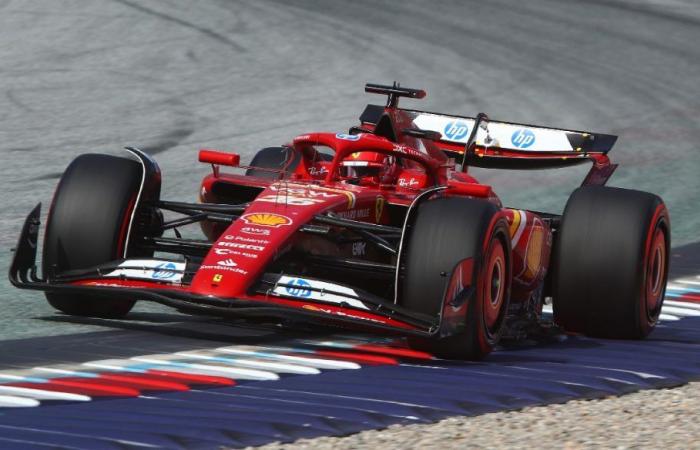Ferrari he at least had a moral obligation to recover some position in the race sprint. We are referring to the 100km mini race that aired around lunchtime. Although no changes to the setup of the SF-24 could be done, one fact had to be considered: with the same set-up of the FP1s, the Prancing Horse had shown a good race pace with almost no degradation. Tests with high amount of fuel on board which although brief, one stint for 6 rounds, they had shown a good performance. For this reason, the hope of doing well and being able to attack their opponents was present in the minds of the Ferrari drivers.
As predicted the tactics for the F1 Sprint it was especially one: to attack. Very aggressive attitude during the first laps, as in the short races “invented” by Liberty Media to raise the spectacle of the weekend and provide more entertainment to the spectators, very often the result is achieved right in the early stages of the competition. So it was with the team Of Maranello. Both pilots of the Ferrari they started off very strong. Sainz he was good with the clutch release which allowed him to challenge the Mercedes Of Russell surpassing it in T1. Even better Leclerc: the Monegasque started off like a slingshot and after overtaking two opponents he triggered a duel with the Red Bull Of Perez went well.
The mini race of the “two Charles” seemed to offer more chance: the Mercedes they were certainly not unbeatable for Charles and the McLaren Of Norris, at least during the first part of the race he didn’t run away. Unfortunately, however, in perfect style Ferraria few too many problems had to appear. We are talking about the braking system of the reds that gave the drivers no peace for the entire duration of the race. It starts with Sainz, the first of the two to suffer from high operating temperatures. Headscratching managed all in all brilliantly by the wall box. However, this aspect had a significant impact on the performance over the course of the tour. On top of that, there’s the tire issue. Although the working range from the Medium was correct, the degree of wear was higher than expected.
A Spielberg the mercury column has risen a lot today. During the Sprint Race the reference plane had a temperature of 46 degrees. For this reason, although the asphalt of the track that unfolds between the mountains of Stiria it is not very abrasive, the tire wear was higher than expected. The positive note for the Ferrari concerns the closed park. From the season 2024in fact, the International Federation allows changes to the set-up before qualifying for the Sunday race. This means that the two reds could “undergo” some further tweaks to the setup. It therefore remained to be understood whether these changes could be effective already in the qualification dedicated to the composition of the second starting grid of the weekend Austrian. An aspect that could potentially partially change the fate of team Italian.
F1, Austrian GP Qualifying: lots of instability in the high-speed sections
Let’s start with the facts: a fourth place for the Spaniard Carlos Sainzonly sixth place for Charles Leclerc. The Iberian takes half a second from the lead Red Bull of his majesty Max Verstappen,. Too much considering that the runway is very short. However, if we look at the gap from the McLaren the Madrid native is just over a tenth. For this reason, taking into account all the problems encountered by the Ferrari in this weekendil gap however rather contained on the two MCL38 can be seen in a positive light. For Leclerc things are worse because 7 tenths are taken over the Dutchman. It’s his fault, we could say, as in the last attempt of the Q3 gets it all wrong. Long on 4, wide on 6 where his tires graze the grass, on the gravel between 9 and 10.
Let’s rewind the tape to understand how today’s qualifying result matured. In the first part of the session the aforementioned hope of a clear improvement in performance seemed to be there. We support this because the excess rotation was present, but it did not seem to be able to affect performance too much. On the contrary, especially in the T1, the performance was better. While in the third sector a good stability was noted in the curves in support at high speed. The cut is thus passed towards the Q2with a little more confidence that any corrections made to the reds could really be effective and shuffle the cards on the table to a minimum.
In the second part of the qualification everyone started to get serious and it is precisely at this juncture that the limits of Ferrari They emerged. We are talking about the same negative characteristics that we observed yesterday, partly masked by the talent of the riders who tried to square up. Sainzdefinitely more comfortable on board the SF-24it doesn’t take much effort and after the first attempt on the Soft used, this time fitting a new compound, it takes a suitable amount of time which allows it to remain intact box without the fear of being eliminated. Charles he suffers more instead. The Ferrari driver is forced to make the third attempt in which, however, he lifts his foot from gas In the T1when the rest of the competitor was unable to improve performance.
The confirmation that the Ferrari in Austrian version it doesn’t work well it comes in Q3. The Ferrari drivers push the car to the limit but the excess rotation complicates everything. In the first sector, oversteer delays the traction phase. Reflectively, the gap accumulated by delaying the acceleration extends to the two very long straights present after curves 1 and 3. In the central sector, curve 6 starts to break the balls, bend to the left where at the apex the rear of the SF-24 can’t follow the front end. Ditto for 7, the first curve of the T3. Third sector where in the rapid downhill section that leads towards the finish straight, the same harmful attitude is clearly noticeable sull’handling of the redhead.
To make a brief technical summary relating to the Ferrari let’s add a comment. In summing up the qualification, a clear fact emerges: in this moment, with the current know how on the new components mounted in Spain, the red’s tuning window is far from wide. Undoubtedly, the blame must be attributed in part to the layout of the track. Spielberg places aerodynamic efficiency as a crucial factor regarding performance. The non-optimal resistance to advancement of the SF-24 it is “balanced” by unloading the rear axle. An operation which, however, cannot be minimized by stiffening the suspensions, because the grip mechanic of the Italian single-seater vanishes. We are talking about a compromise that currently for the Ferrari does not exist…





